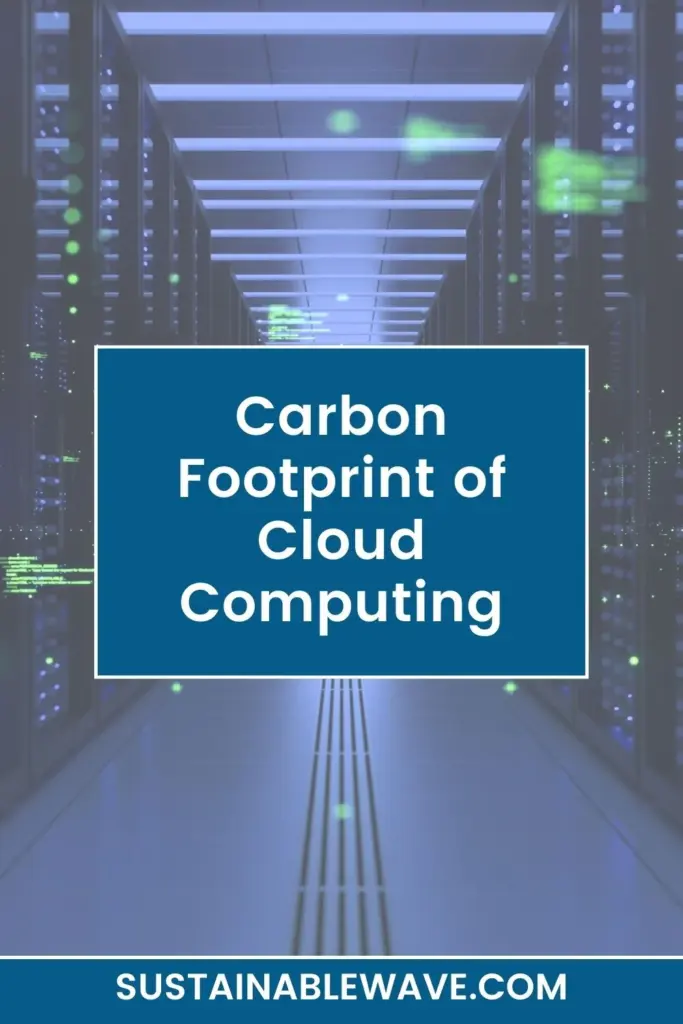With the exponential growth of the digital era, cloud computing has become the backbone of modern-day businesses, streaming services, and even our personal storage solutions. But the Carbon Footprint of Cloud Computing might be more significant than you think.
Storing up to 100 gigabytes of data annually in the cloud leads to a carbon output equivalent to approximately 0.2 tons of CO2, considering the typical U.S. energy blend.
Let’s pull back the curtain on this modern marvel.
The Basics of Cloud Computing

At its core, cloud computing is the delivery of computing services—ranging from storage to processing power—over the internet, or “the cloud.” But how does this virtual storage space operate? Let’s dive in!
Believe it or not, the “cloud” isn’t in the sky. It consists of physical data centers around the world, housing countless servers. These mammoth facilities require a significant amount of energy to function, leading us to question their environmental footprint.
Carbon Footprint Explained
In today’s fast-paced world, the term “carbon footprint” gets thrown around quite often. But what does it genuinely signify? The carbon footprint refers to the total volume of greenhouse gas emissions that an individual, group, product, or service directly or indirectly produces.
These emissions are typically measured in units of carbon dioxide equivalents, given that carbon dioxide is the most prevalent greenhouse gas resulting from human activities.
Think of it this way: every time you drive your car, turn on a light or even cook a meal, you’re adding to your carbon footprint.
Much like our physical footprint leaves a mark on the ground, our carbon footprint leaves a mark on our planet. And in our technologically driven era, the gadgets and services we use, like cloud computing, contribute to this footprint in ways we might not immediately recognize.
The Role of Technology in Carbon Emissions
To many, the devices we carry and the invisible cloud we access seem harmless. After all, they don’t produce smoke or leave trash behind. However, the digital realm’s infrastructure—servers, data centers, network devices—consumes vast amounts of energy.
The production of our smartphones, laptops, and other devices also demands energy and raw materials, leading to carbon emissions even before we turn them on for the first time.
But it’s not just about the devices we hold. The software applications and platforms we use, from social media to online banking, are housed in data centers that require electricity 24/7. These technological marvels make our lives easier and connect us in unprecedented ways, but they come at a cost to our planet.
Cloud Computing’s Environmental Impact
Data centers are akin to the beating hearts of the internet. They store, process, and manage vast amounts of data from around the globe. To say they’re energy-intensive would be an understatement. These facilities run day and night, ensuring uninterrupted services, and require not just energy to power the servers but also extensive cooling systems to prevent overheating.
Traditional data centers can consume as much electricity as a small town. Why? Imagine thousands, if not millions, of high-performance computers packed in a building, processing data non-stop. These computers produce heat. To avoid meltdowns, cooling systems, often in the form of large air conditioners, work tirelessly, consuming even more energy.
Carbon Emissions: A Byproduct of the Cloud?
The crux of the matter is the source of this energy. Many data centers around the world still rely on non-renewable energy sources, such as coal or natural gas. The burning of these fossil fuels releases significant amounts of carbon dioxide into the atmosphere, contributing to global warming.
To paint a clearer picture, consider this: A study found that if the cloud were a country, its electricity demand would rank sixth in the world! Such comparisons help drive home the reality that our virtual actions—streaming a movie, storing photos, or even sending an email—have tangible consequences on our environment.
Furthermore, the rapid growth of digital data means more data centers and more energy consumption. The exponential increase in Internet of Things (IoT) devices, higher-resolution media files, and AI-driven applications put additional pressure on these infrastructures, potentially accelerating their carbon emissions.
Solutions and Green Initiatives
The environmental concerns tied to cloud computing have not gone unnoticed. As awareness grows, many companies and organizations are exploring ways to reduce their digital carbon footprint, primarily by integrating renewable energy sources into their operations.
Solar panels and wind turbines are increasingly sprouting up around data centers, harnessing nature’s power to fuel our digital demands. The beauty of these renewable sources lies in their sustainability; they don’t deplete over time and don’t emit harmful greenhouse gases.
By transitioning to these cleaner energy alternatives, data centers can significantly reduce their carbon emissions and pave the way for a greener digital landscape.
But the switch to renewables isn’t just about installing a few solar panels. It involves revamping energy infrastructures, forging partnerships with renewable energy providers, and sometimes even influencing local energy policies.
Leading Companies Paving the Way
Some of the world’s tech giants have taken commendable steps toward sustainable cloud computing. Google, for instance, has been carbon-neutral since 2007 and is working toward operating all its data centers with carbon-free energy around the clock. Meanwhile, Amazon Web Services (AWS) has set its sights on powering its global infrastructure with 100% renewable energy.
Such commitments from industry leaders set a precedent and can inspire smaller companies to adopt similar green initiatives. Their investments in renewable energy solutions and research also accelerate the development of more efficient and affordable green technologies, benefiting the entire sector.
The Future of Cloud Computing
While today’s cloud computing landscape has its environmental challenges, the future is looking increasingly green. As businesses and consumers alike become more eco-conscious, there’s a growing demand for sustainable digital services.
This trend toward sustainability is influencing not only how data centers are powered but also how they’re designed. Concepts like free cooling, which leverages ambient outside air for cooling instead of energy-intensive air conditioners, are gaining traction. Data center locations are also being strategically chosen based on renewable energy availability and naturally cooler climates to minimize cooling needs.
Technological Innovations for a Greener Future
Beyond sustainable energy sources and infrastructure design, technological advancements hold the promise of further reducing the carbon footprint of cloud computing. Artificial Intelligence (AI), for instance, is being used to predict the cooling needs of data centers, optimizing energy consumption.
Additionally, innovations in server design, data storage efficiency, and software optimization can all contribute to a reduction in energy use. As technology continues to evolve, we’ll likely witness a convergence of performance and efficiency, where the digital services we rely on become both faster and more environmentally friendly.
Key Takeaways From The Carbon Footprint of Cloud Computing

The digital realm’s carbon footprint is undeniable, but so is the tech industry’s commitment to finding sustainable solutions.
As we look to the future, it’s clear that cloud computing will not only continue to shape our digital experiences but also play a pivotal role in our global sustainability efforts.
In this delicate balance of innovation and responsibility, there’s immense potential for positive change.
I’m Thomas, the owner of SustainableWave. Passionately promoting a sustainable planet. With experience in various eco-roles, I’ll share green tips, sustainability hacks, and personal eco-journeys on my blog.






